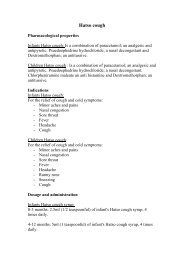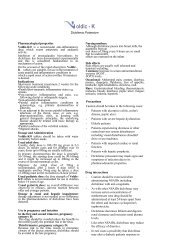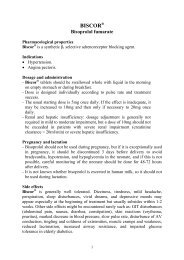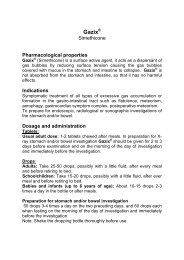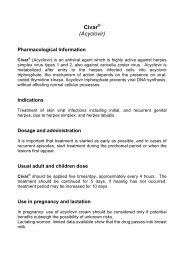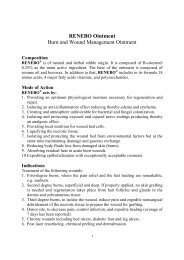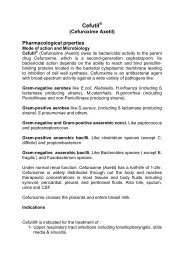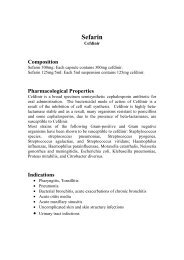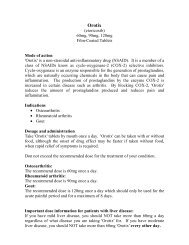( Clarithromycin ) - PIC-JO > Home
( Clarithromycin ) - PIC-JO > Home
( Clarithromycin ) - PIC-JO > Home
You also want an ePaper? Increase the reach of your titles
YUMPU automatically turns print PDFs into web optimized ePapers that Google loves.
Clarix ®<br />
(<strong>Clarithromycin</strong>)<br />
Pharmacological properties<br />
Clarix ® is a semi-synthetic macrolide antibiotic, it exerts its antibacterial<br />
activity by inhibition of protein synthesis through linkage to 50 S ribosomal<br />
subunit.<br />
Clarix ® is active in vitro against the following microorganisms:<br />
Streptococcus agalacticae, Streptococcus pyogenes, Streptococcus viridans,<br />
Streptococcus pneumoniae, Haemophilus influenzae. Haemophilus<br />
parainfluenzae, Neisseria gonorrhea, Listeria monocytogenes, Legionella<br />
pneumophila, Mycoplasma pneumoniae, Campylobacter pylori, Campylobacter<br />
jejuni, Chlamydia trachomatis, Branhamella catarrhalis, Bordetella pertussis,<br />
Staphylococcus aureus, Propionibacterium acnes & Helicobacter pylori.<br />
Indications<br />
Treatment of infections caused by microorganisms sensitive to Clarix ® such as:<br />
- Infections of nasopharyngeal tract (tonsillitis, pharyngitis) and paranasal<br />
sinusitis.<br />
- Lower respiratory tract infections: bronchitis, bacterial pneumonia and<br />
atypical pneumonia.<br />
- Skin infections: impetigo, erysipelas, folliculitis, furunculosis and septic<br />
wounds.<br />
- To eradicate helicobacter pylori in the treatment regimens for peptic ulcer.<br />
Dosage and administration<br />
Respiratory tract / skin and soft tissue infections<br />
Usual adult dose:<br />
- 250 mg every 12 hours, in severe cases dosage can be increased to 500<br />
mg every 12 hours.<br />
- Clarix ® can be taken without regard to meals.<br />
Side effects<br />
GI disturbances (nausea, vomiting & diarrhea), headache, skin rashes &<br />
reversible increase in liver enzymes.<br />
Rarely, cholestatic hepatitis, and superinfections by resistant microorganisms<br />
can occur.<br />
Precautions<br />
- In patients with renal impairment & creatinine clearance below 30 ml /min,<br />
the dose of clarithromycin should be reduced to one – half>
- Also Particular caution should be taken when administering the drug to<br />
elderly patients (above 65 years old) or patients with impaired liver function.<br />
Drug interactions<br />
- <strong>Clarithromycin</strong> may increase carbamazepine plasma levels significantly thus<br />
patients under such combination must be monitored carefully.<br />
- Like other macrolides, possible interaction with warfarin and cyclosporins<br />
may occur.<br />
- Co-adminisration with theophylline may increase the plasma level of<br />
theophylline but not to a significant extent that need dosage adjustment.<br />
Contraindications<br />
Patients with known hypersensitivity to macrolides, pregnancy, breast feeding<br />
and severe liver insufficiency.<br />
Overdosage<br />
In case of clarithromycin overdosage, gastric lavage and supportive measures<br />
are indicated.<br />
Presentation<br />
Clarix ® 250mg F/C tablet: <strong>Clarithromycin</strong> 250mg/tablet. (Available in different<br />
pack sizes)<br />
Clarix ® 500mg F/C tablet: <strong>Clarithromycin</strong> 500mg/tablet. (Available in different<br />
pack sizes)




